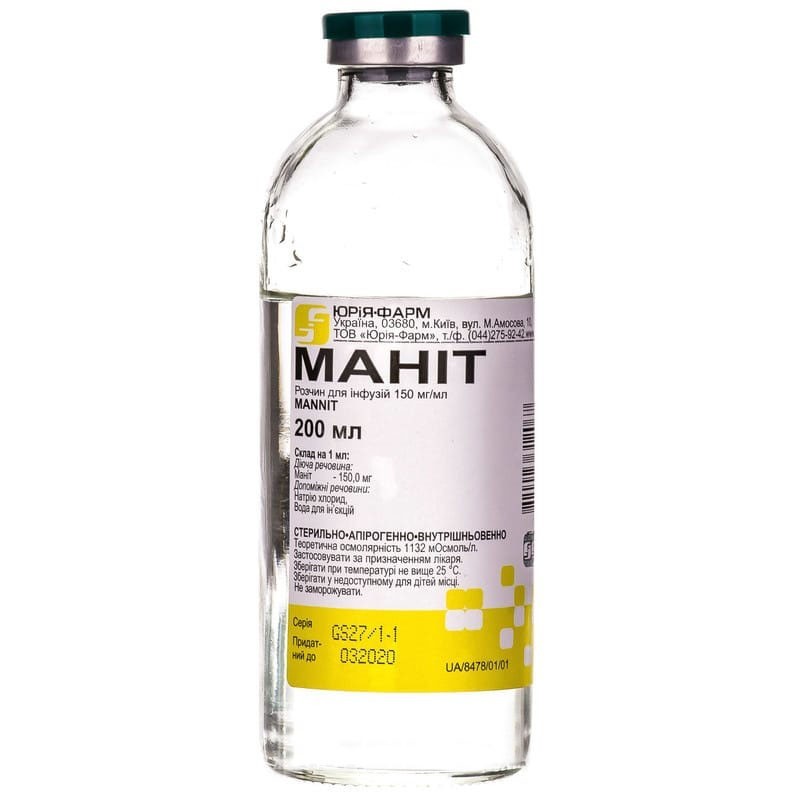



 Secure and encrypted payment processing
Secure and encrypted payment processing We ship to over 40 countries including the USA, UK, Europe, Australia and Japan
We ship to over 40 countries including the USA, UK, Europe, Australia and Japan Guaranteed refund or reship if you haven't received your order
Guaranteed refund or reship if you haven't received your orderMannitol has a pronounced diuretic effect due to an increase in the osmotic pressure of blood plasma and filtration without subsequent tubular reabsorption, leads to water retention in the tubules and an increase in urine volume, increasing the osmolarity of blood plasma, which leads to the movement of fluid from the tissues into the vascular bed. it contributes to the rapid removal of fluid from the vascular bed, increases renal blood flow, thereby reducing renal tissue hypoxia. does not affect glomerular filtration. diuresis is accompanied by the removal of a significant amount of sodium without a noticeable effect on the excretion of potassium. the diuretic effect is determined by the amount and speed of the drug administered and filtered by the kidneys, therefore it is ineffective in violation of the filtering function of the kidneys, as well as azotemia in patients with cirrhosis and ascites. causes an increase in bcc (through an increase in the osmotic pressure in the vascular bed). after iv administration, it reduces the reabsorption of water, increases the bcc, has a diuretic effect, and reduces intracranial pressure.
Filtered by the kidneys without subsequent tubular reabsorption. The elimination half-life is 100 minutes (in acute renal failure, it can increase up to 36 hours). The diuretic effect is manifested 1-3 hours after administration, a decrease in CSF pressure and intraocular pressure within 15 minutes after the start of the infusion. The maximum decrease in intraocular pressure is noted 30-60 minutes after the start of administration. A decrease in CSF pressure persists for 3–8 hours, a decrease in intraocular pressure lasts for 4–8 hours after the end of the infusion. Mannitol is slightly metabolized in the liver to form glycogen.
Approximately 80% of the administered dose is excreted in the urine for 3 hours.
With renal failure, the elimination half-life can increase to 36 hours.
Cerebral edema, cerebral hypertension, acute hepatic and renal failure with preserved filtration capacity of the kidneys and other conditions that require increased diuresis (status epilepticus, acute glaucoma, surgery using extracorporeal circulation, post-transfusion complication after administration of incompatible blood, poisoning with barbiturates and other )
The drug is administered in / drip or slowly in a jet. the total dose and rate of administration depend on the indications and clinical condition of the patient.
Adults are injected with 50-100 g of the drug at a rate that provides a level of diuresis of at least 30-50 ml / h. With cerebral edema, increased intracranial pressure or glaucoma, an infusion of 0.25–1 g / kg of body weight is carried out for 30–60 minutes. In patients with low body weight or exhausted patients, a dose of 0.5 g / kg is sufficient. In case of poisoning, 50–180 g are administered with an infusion rate that provides diuresis at the level of 100–500 ml / h. The maximum dose for adults is 140-180 g for 24 hours.
Children, as a diuretic, are given iv in a drip at the rate of 0.25–1 g / kg or 30 g / m2 body surface for 2-6 hours. With cerebral edema, increased intracranial pressure or glaucoma - 0.5–1 g / kg or 15–30 g / m2 body surface for 30-60 minutes. In children with low body weight or exhausted patients, a dose of 0.5 g / kg is sufficient. In case of poisoning in children, an intravenous infusion is carried out at a dose of up to 2 g / kg body weight or 60 g / m2 body surface.
Hypersensitivity to the drug; severe heart failure; severe forms of dehydration; hyperosmolar state, renal failure with impaired renal filtration; hemorrhagic stroke; subarachnoid hemorrhage; hypernatremia; hypochloremia; hypokalemia.not used for brain lesions, which are accompanied by a violation of the integrity of the GEB, coma.
Dehydration (dry skin, dyspepsia, muscle weakness, cramps, dry mouth, thirst, hallucinations, decreased hell), tachycardia, chest pain, phlebitis, hyponatremia, hypokalemia, skin rashes.
It is necessary to control the level of hell, diuresis, osmotic blood, balance of water and ions with indicators of central hemodynamics. prescribed with caution in patients with chronic heart failure. in case of symptoms such as headache, dizziness, vomiting, visual impairment, it is necessary to stop the administration of the drug.
During pregnancy and lactation, Mannitol is used only in cases where the expected benefit to the mother outweighs the possible risk to the fetus or child.
Potentiates the diuretic effect of saluretics, carbonic anhydrase inhibitors and other diuretics. when combined with neomycin, the risk of developing oto- and nephrotoxic reactions increases. the administration of mannitol simultaneously with cardiac glycosides is not allowed due to a possible increase in their toxic effect.
Rapid administration of the drug in high doses can lead to an increase in the volume of extracellular fluid, hyponatremia and hyperkalemia, as well as to overload by the volume of the heart, especially in patients with acute or chronic renal failure, dehydration.
The treatment is symptomatic.
At temperatures from 5 ° C to 25 ° C.
In case of crystals precipitation, the preparation is heated in a steam bath at a temperature of 50–70 ° С. When the crystals dissolve, the solution will become transparent, and if the crystals do not fall out again when cooled to a temperature below 36 ° C, the preparation is suitable for use.
Non-wetting of the inner surface of the bottles is not a contraindication for the use of the drug.